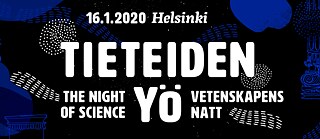AI, Machine Translation and Cultural Diversity
Humans versus Translation Engines

What are the dangers of machine translation? And what does its future hold? At the “Night of Science”, researchers, professors and translators discussed the topic of Artificial Intelligence, Machine Translation and Cultural Diversity at the Goethe-Institut Finland.
By Heidi Backström
When it comes to artificial intelligence, we often focus on threatening scenarios. The “Night of Science” put the emphasis differently: Machine translation considerably speeds up translation work and enables faster access to texts in several languages.
Machine translation is nothing new, even if the present-day hype about artificial intelligence makes it seems so. In 1954, Georgetown University in Washington D.C. was able to machine translate more than sixty sentences from Russian into English. Ever since, it’s been said that machines will soon replace people in translation work. In reality, though, machine translation has been quite slow to develop. Only now, in the 2020s, has the quality of machine translation begun to attain a truly useful level.

How intelligent is machine translation??
A project by the Goethe-Institut Finland in cooperation with the University of Helsinki specially developed a translation machine for Finnish and German for the institute’s own needs. The project is headed by Professor Jörg Tiedemann. In autumn 2019, a new translation machine of the same type was launched in the Finnish State Chancellery. Translators Päivi Creber and Alexandra Kellner, both of whom work at the Finnish State Chancellery, were pleasantly surprised by its quality.“The program is alarmingly good,” laughs Alexandra Kellner at the “Night of Science.” “The generated text is so fluid that you have to look very closely to detect any errors.” For example, a translation machine doesn’t always distinguish a subject from an object. If a translator were to overlook a mistake like that it could be embarrassing or even dangerous. The most frequent errors in content occur with adages and puns. Specific vocabularies, such as bird species, are also problematic for artificial intelligence.
Machines don’t think
“We talk about artificial intelligence as if it were a human being. We use words like ‘think’ and ‘invent.’ But machines don’t think. When asked whether translation machines are intelligent or not, one could ask the opposite question: Can they be intelligent if they don’t distinguish an object from a subject?” says researcher Maarit Koponen, who has dealt intensively with machine translation.Threat or helper?
Both translators consider translation machine a good tool; but not a threat to their work. “The world is changing, and the work is changing as well,” says translator Päivi Creber. The machine creates a rough translation, but the translators play an important role, especially in checking that the text is correct.The machine makes work on site easier and offers space for the translators’ creativity. “The decisions are always made by the translator, not the machine,” Creber sums up. Human translators, for example, think about who will be reading the text and what additional information the recipient may need. Machines don’t understand the different target groups.
Sensitive and reliable
Professor Jörg Tiedemann points out that every translation is a corrupted version of the original text. Translations are therefore always about trust in the translator. The scholar Maarit Koponen attaches great importance to the fact that reliability and values linked to translation machines are clearly discussed in as many contexts as possible. There is no completely neutral database and therefore no neutral translation machine.One of the key questions pursued by the Goethe-Institut and University of Helsinki project was whether machines can be trained to take cultural differences into account. How biased and polarising is a text produced by a translation machine? Can it be politically correct? “The Night of Science” provided no definitive answers to these questions, but the question about the bias of artificial intelligence is an urgent one.
The future of (machine) translation
The need for translations is increasing in the globalised world. Tiedemann predicts that there will be more translation machines in the future that specialise in specific purposes. The Goethe-Institut Finland project demonstrated that a tailor-made machine that uses only limited source material can quickly outperform conventional translation machines.The translator Päivi Creber believes that the need for people to translate certain types of texts will decrease or even disappear in less than ten years. However, neither Creber nor her colleague Alexandra Kellner thinks that machine translation will ever be the solution for translating every kind of text. “The machine works for certain requirements, but for others, only a human being will do.”
German translation: Marjukka Mäkelä and the translation tool of the project.